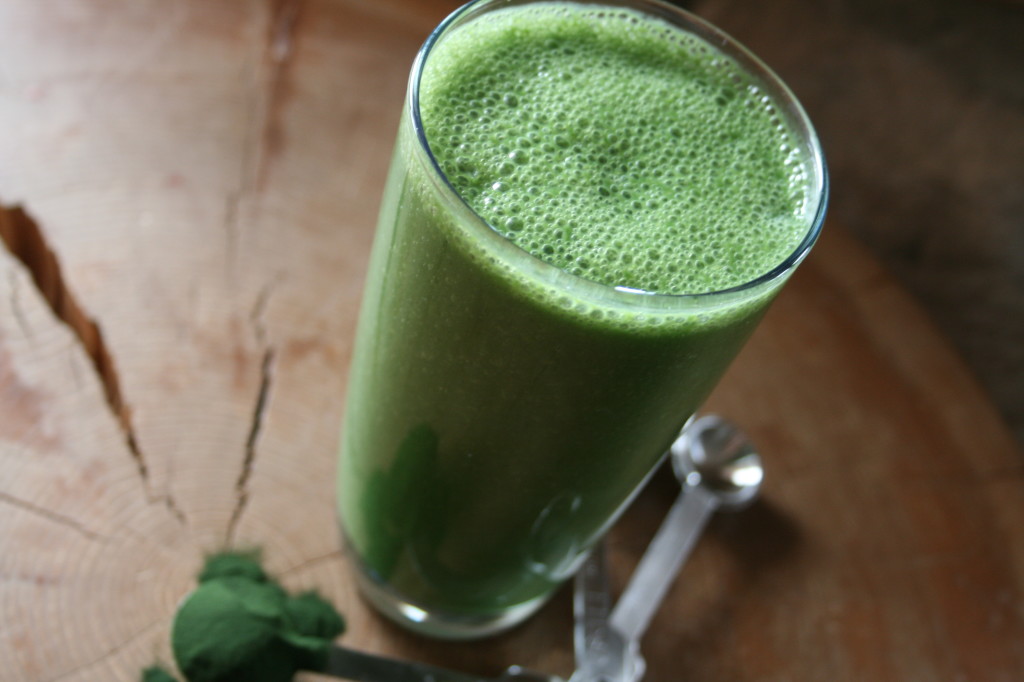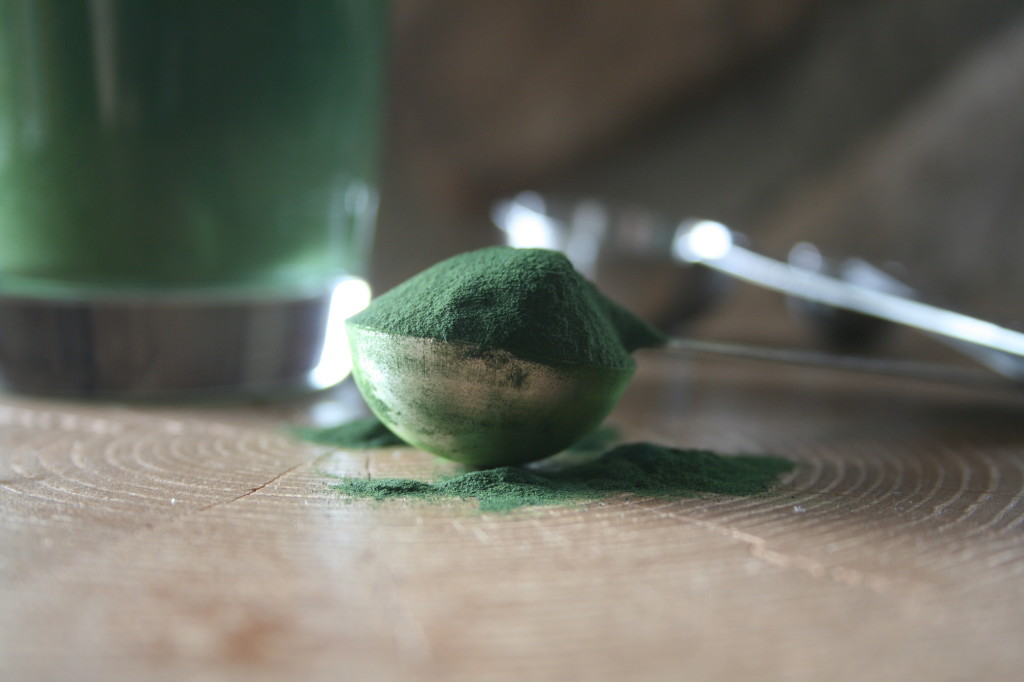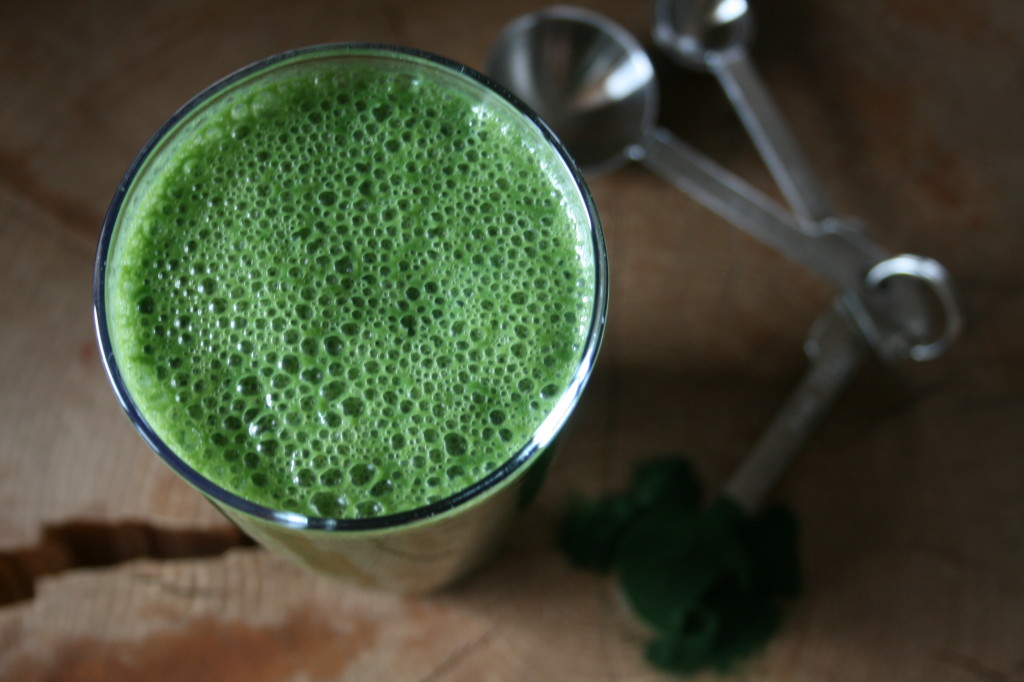 One of the trendiest ingredients out there for smoothies is chlorella and/or spirulina powder. It is very fine and a rich evergreen colour with impressive nutritional components. It is one of those foods that tastes as healthy as it is- it’s pretty gross but once the smoothie is blended you cannot taste or smell it at all, you only get the benefits. Chlorella and spirulina are both microalgaes rich in antioxidants, B vitamins, chlorophyll, calcium, iron, zinc, protein and essential fatty acids. A lot of the (warranted) hype around these products is based on its alkalizing and chelating abilities.
One of the trendiest ingredients out there for smoothies is chlorella and/or spirulina powder. It is very fine and a rich evergreen colour with impressive nutritional components. It is one of those foods that tastes as healthy as it is- it’s pretty gross but once the smoothie is blended you cannot taste or smell it at all, you only get the benefits. Chlorella and spirulina are both microalgaes rich in antioxidants, B vitamins, chlorophyll, calcium, iron, zinc, protein and essential fatty acids. A lot of the (warranted) hype around these products is based on its alkalizing and chelating abilities.
Our blood needs to be maintained at a specific point (7.35-7.45) on the pH scale, which ranges from 0 to 14. 7 is considered neutral, anything below is acidic and the closer to 0 the more acidic it gets, whereas anything above is alkaline, becoming more alkaline the closer to 14 it is. What we eat and drink has an influence on our blood’s pH. When we are eating a diet high in acidic food, or basically everything in the Standard American Diet including meats, refined grains, coffee, alcohol and processed sugar, our body will use buffers to maintain a safe level. One of these buffers is pulling calcium from the bones to offset excess acidity. Calcium is a mineral that we are often convinced we need more of by food marketers because if we are deficient then developing osteoporosis, a medical condition where bones become brittle and fragile, is a really strong possibility. The irony is that most of these foods are acidic, so even if they are fortified with calcium they may not be as beneficial as reported. If you are concerned about your calcium levels and bone health, getting your levels tested by blood will not give as true an indication as getting the levels in your bones tested and adding some smoothies with alkaline leafy greens and these alkaline algaes can help. If you want to find out about specific foods just search “pH food chart” or “pH _____(food type)” and lots of easy to understand diagrams will come up.
While a lot of our modern, convenient food is acidic and contributing to health issues, a lot of our modern plumbing, beauty products, dental work, kitchen utensils, farming practices (man made fertilizers and pesticides) and medication is leaving our bodies with an accumulation of toxic/heavy minerals like lead, cadmium, mercury and aluminum. Each poses their own health risks and has connections to different issues like ADD and Alzheimer’s disease. Moreover, each has the ability to displace minerals that we do need for different bodily functions, which can force deficiencies to happen. While these metals can potentially accumulate and stay in our tissues for our whole lives, it is possible to help the body eliminate them with the help of chelators. They bind to toxic minerals and carry them out of the body through elimination channels. There are medications that do this, but only for people with severe metal poisoning. For lower levels this would be dangerous, but we can consume foods that have chelating abilities such as chlorella (spirulina is mentionable but not shown to be as effective as chlorella). Some other foods with these abilities are cilantro, parsley, cruciferous vegetables, onions and garlic (for their high sulfur contents) and amino acids (the building blocks of protein) as found in high and easily digestible protein foods like fish and eggs.
*IMPORTANT NOTE: If you are looking further into pH balance or chelation make sure to only depend on published peer-reviewed articles in medical/scientific journals. There are a lot of natural health websites and self-proclaimed experts that have a large following but regularly provide misinformation, sometimes it is even in direct conflict to what has proven to be scientifically valid. They may be more charismatic than your doctor but following wrong advice too stringently can be dangerous. While it can be empowering to educate ourselves, there are a lot of people and businesses out there that will take advantage of people who are worried about their health.*
Spirulina already has broken cell walls so it is easy to digest but with chlorella it is best to get brands that specify that the cell walls have been broken/cracked, otherwise your body will not be able to break down and absorb the nutrients as well. Both these algaes are similar but have their own unique specialties so I like to use a blend of the two (I’ve been using the Prairie Naturals brand, it’s more expensive than some other brands but really good quality). I throw it into pretty much every smoothie I make but the version below is simple and only uses lighter colour ingredients that don’t detract from the beautiful vibrant green of the kale and algaes. 
- 2 cups kale, de-stemmed and loosely packed
- 1 cup plain unsweetened nut milk
- 1 cup pineapple, fresh or frozen, diced
- 1 frozen banana, sliced (peel before freezing)
- 1 teaspoon chlorella or spirulina or a blend of the two in powder form
- Optional: 1-2 medjool dates for extra sweetness
- Blend all ingredients together until fully broken down.

